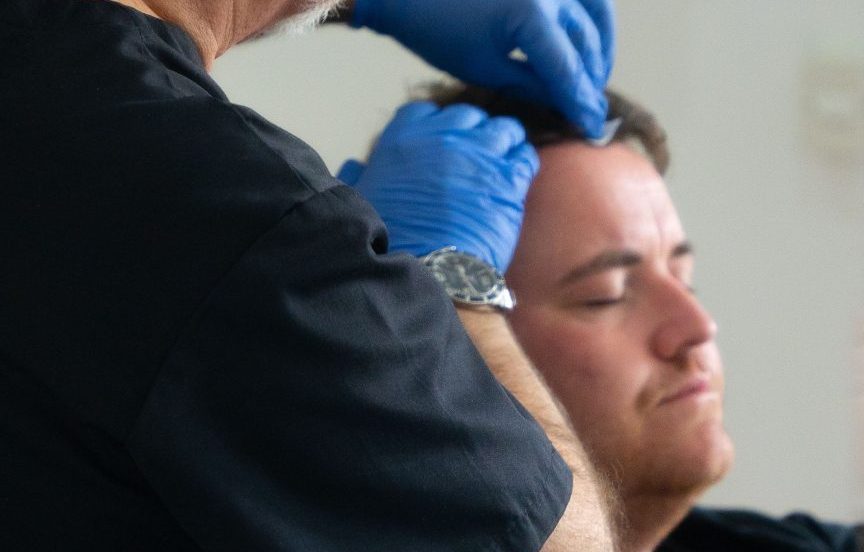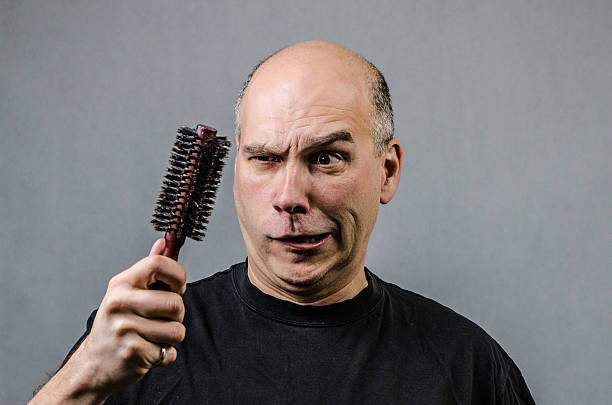
The Science Behind Hair Loss: DHT and Its Role

The Science Behind Hair Loss
DHT and Its Role
Explore how DHT (dihydrotestosterone) contributes to hair loss by shrinking hair follicles and disrupting growth cycles. Learn about the science behind androgenic alopecia and effective treatments.
DHT
Dihydrotestosterone (DHT) is a powerful hormone derived from testosterone, known to shrink hair follicles
testosterone
in both men and women and serves multiple functions, When it interacts with the enzyme 5-alpha-reductase ..
Stress
High-fat diets, lack of essential nutrients, smoking, and stress can worsen hormonal imbalances ...
Understanding DHT: The Hidden Cause of Hair Loss and How to Fight Back
Hair loss isn’t just about appearance—it’s about confidence, identity, and well-being. It’s that sinking feeling when your hairbrush fills up quicker than usual or you realise your once-thick hairline gradually creeps backwards. For many, it marks the beginning of a frustrating journey, often clouded by myths, misleading products, and emotional strain.
But understanding what’s happening beneath the surface is the key to taking back control. A potent hormone known as DHT is one of the primary forces driving hair loss, especially male and female pattern baldness. This article unravels the science behind DHT, how it interferes with your hair growth, and, most importantly, what you can do about it. Plus, we’ll introduce how Merchant City Medical Group offers tailored solutions to help you restore your hair and confidence.
Understanding Hair Loss: A Common Yet Complex Condition
Hair loss doesn’t discriminate. It affects people of all ages, genders, and backgrounds. While some experience gradual thinning over the years, others face sudden and unexpected shedding. To tackle hair loss effectively, it’s crucial to grasp its different forms and what triggers them.
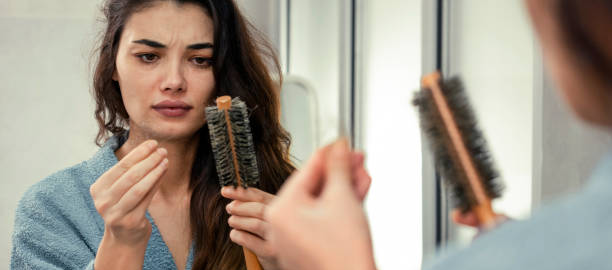
1 .What is Hair Loss?
Hair loss, medically known as alopecia, refers to hair’s partial or complete absence from areas where it normally grows. While losing 50 to 100 hairs daily is common in the natural growth cycle, excessive shedding can signal an underlying issue.


- 2,190 Grafts
- 12 Months Post Op
2 .Types of Hair Loss (Alopecia)
- Androgenetic alopecia—commonly known as male or female pattern baldness—is the most widespread type of hair loss and is strongly linked to DHT.
- Telogen Effluvium: Temporary shedding due to stress, illness, or hormonal shifts.
- Alopecia Areata: The immune system targets hair follicles in an autoimmune disease.
3 . Why Is Hair Loss Increasing?
Today’s fast-paced lifestyle contributes to increasing cases of hair loss. Stress, pollution, poor nutrition, and hormonal imbalances are key culprits. Genetics also plays a significant role, particularly in androgenetic alopecia.


- 2,190 Grafts
- 12 Months Post Op
What is DHT? The Hormone Behind Hair Loss
Ever wondered why some people are more prone to baldness despite similar lifestyles? The answer often lies in a hormone called dihydrotestosterone (DHT). This potent form of testosterone has a direct impact on hair follicles.
-
The Role of Testosterone and DHT
Testosterone is present in both men and women and serves multiple functions, from muscle development to libido. When it interacts with the enzyme 5-alpha-reductase, it converts into DHT. This conversion is completely natural and necessary for various body functions. -
How DHT is Produced in the Body
DHT is created primarily in the skin, liver, and prostate. While essential for developing male characteristics during puberty, its presence in adulthood can trigger problems, especially for hair follicles. -
DHT's Impact on Hair Follicles
Hair follicles contain androgen receptors that bind with DHT. In genetically predisposed individuals, this binding causes the hair follicle to shrink over time, leading to shorter, finer hair. Eventually, the follicle stops producing new hair altogether.
How DHT Causes Hair Loss: The Scientific Explanation
Hair loss due to DHT doesn’t happen overnight. It’s a slow, progressive process that many don’t notice until it’s well underway. Let’s break down how DHT systematically affects your scalp.
-
Sensitivity of Hair Follicles to DHT
DHT does not affect every hair follicle in the same way. Those in the temples, crown, and frontal scalp are especially vulnerable. This is why male pattern baldness often follows a predictable pattern. -
Why DHT Affects the Scalp More Than Other Areas
Interestingly, DHT promotes hair growth in some body areas (like the chest) but inhibits it on the scalp. This is because scalp follicles are genetically sensitive to DHT, particularly in the frontal and vertex regions. -
DHT and Male Pattern Baldness (MPB)
Male pattern baldness typically starts with a thinning crown or a receding hairline and may progress to full baldness. While the hair follicles remain present, they become inactive due to the effects of DHT. -
DHT and Female Pattern Hair Loss
Women produce less testosterone, hence lower DHT levels. However, post-menopausal hormonal changes can increase sensitivity. Female pattern hair loss typically results in overall thinning rather than patchy bald spots.
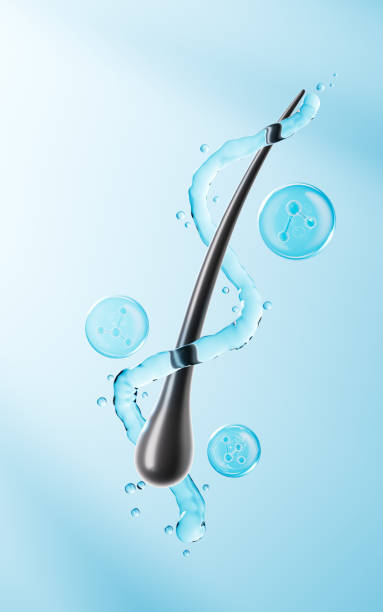
Risk Factors that Increase DHT Sensitivity
While DHT plays a significant role, it doesn’t act alone. Several risk factors can increase your susceptibility to hair loss.
1. Genetics and Family History
Hair Loss and the Role of Genetics
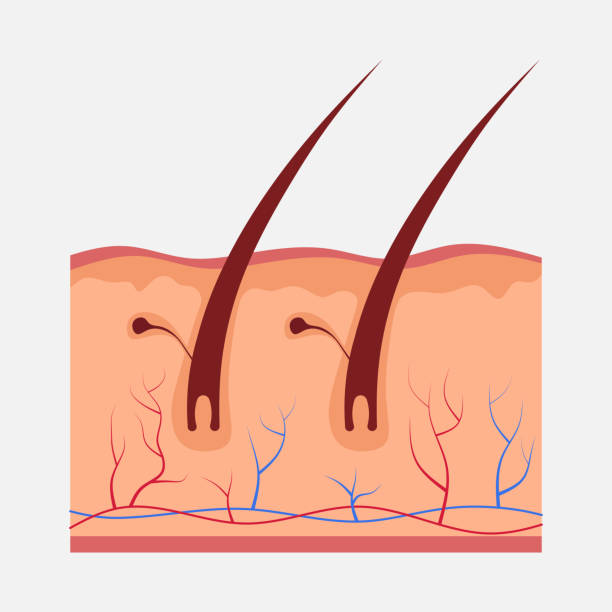
If your father, mother, or grandparents experienced hair loss, there’s a strong likelihood you may too. Your genetic makeup determines how sensitive your follicles are to DHT.
2. Age and Hormonal Changes
Aging, Hormones, and Hair Loss
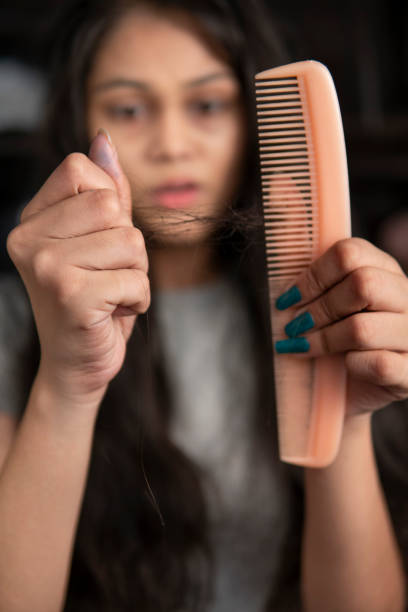
Hormonal levels fluctuate as you age. This shift can lead to increased DHT production or heightened follicle sensitivity.

3. Diet, Lifestyle, and Stress
Lifestyle Factors That Fuel Hair Loss
High-fat diets, lack of essential nutrients, smoking, and stress can worsen hormonal imbalances and inflammation, contributing to hair loss.
Signs Your Hair Loss May Be DHT-Related
Knowing what to look for can help you act early and seek appropriate treatment. DHT-related hair loss presents itself in specific patterns and timelines.
- Receding Hairline and Thinning at the Crown
DHT might be the culprit if you notice a widening part or a receding front hairline. In men, the crown is often the first to thin. - Slow Regrowth and Excessive Shedding
You may see fewer new hairs growing in and more hair collecting on your pillow or in the shower drain. - How to Differentiate DHT Hair Loss from Other Types
DHT-related hair loss is usually gradual and patterned. Sudden, patchy, or complete loss may suggest other causes, such as autoimmune conditions or medication side effects.
Diagnosing DHT-Driven Hair Loss
Diagnosis is key to effective treatment. A professional evaluation will help determine if DHT is behind your hair loss.
- Scalp Examination by a Specialist
A trichologist or dermatologist examines your scalp for patterns, density, and signs of miniaturisation. - Hormonal and Blood Tests
Testing testosterone, DHT, thyroid function, and iron levels can reveal imbalances or deficiencies contributing to hair loss. - Trichoscopy and Follicle Analysis
Advanced techniques like trichoscopy magnify the scalp, allowing specialists to study follicle health, size, and growth phases.
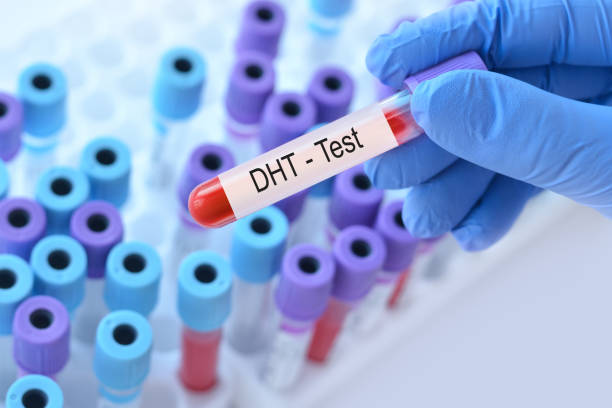
DHT Blockers and Medical Treatments for Hair Loss
There’s hope for those experiencing DHT-induced hair loss. Several treatments are available to block DHT production or reverse its effects.
- Finasteride and Dutasteride: Prescription DHT Inhibitors
These oral medications reduce DHT levels by blocking the 5-alpha-reductase enzyme. Finasteride is the most widely prescribed and effective in halting progression. - Minoxidil and Other Topical Treatments
Minoxidil doesn’t block DHT but enhances blood flow and prolongs the growth phase. For best results, it’s often used alongside oral medication. - Natural DHT Blockers: Do They Work?
Ingredients like saw palmetto, pumpkin seed oil, and green tea are thought to inhibit DHT naturally. While results vary, they may offer mild support when used consistently. - Side Effects and What to Expect
Prescription DHT blockers can have side effects, including sexual dysfunction and hormonal changes. Always consult a professional before starting treatment.
Advanced Solutions: Hair Transplants and Regenerative Therapies
When hair loss has progressed significantly, medical treatments may not suffice. In such cases, surgical and regenerative options offer a promising way forward. Hair Transplant is the way out, and here are popular methods.
- FUE (Follicular Unit Extraction) vs FUT
In FUE, hairs are taken one by one from a part of the scalp with plenty of hair and placed where hair is missing. FUT removes a strip of the scalp to harvest follicles. FUE is a gentle procedure that causes little scarring and doesn’t involve major surgery. - PRP Therapy (Platelet-Rich Plasma)
The PRP therapy (platelet-rich plasma) involves injecting your blood platelets into the scalp to stimulate hair growth and repair. It can complement other treatments or be used alone. - Laser Therapy and Stem Cell Solutions
Low-level laser therapy (LLLT) stimulates follicles using red light. Although still under study, stem cell treatments show potential in regenerating damaged follicles.

Lifestyle Tips to Minimise DHT Impact
Small lifestyle changes can make a big difference in managing DHT and maintaining healthy hair.
- Diet and Supplements that Support Hair Health
A diet rich in zinc, biotin, iron, and omega-3 fatty acids supports follicle function. Supplements like collagen and silica may also strengthen strands. - Stress Management and Scalp Care
Stress releases cortisol, which affects hormone levels. Regular exercise, meditation, and good sleep can help. Scalp massages increase circulation and may promote growth. - Reducing Toxins and Promoting Circulation
Avoid harsh shampoos with sulphates and parabens. Use gentle, nourishing products, and consider weekly scalp exfoliation.
Merchant City Medical Group: Your Partner in Hair Restoration
Merchant City Medical Group is a leading provider of personalised hair restoration solutions for those seeking expert care.
- Why Choose Merchant City Medical Group?
With years of experience in advanced hair restoration, the team at Merchant City offers tailored solutions based on your specific hair loss condition. Whether in the early stages or facing advanced thinning, you’ll find a treatment plan suited to your needs. - Personalised Hair Loss Consultation
Each journey begins with a thorough consultation. Experts evaluate your scalp, health history, and lifestyle to determine the best action. - Proven Results and Patient Testimonials
Countless patients have regained their confidence and hairline thanks to Merchant City Medical Group’s skilled practitioners and state-of-the-art technology. - Booking a Consultation and Next Steps
Taking the first step is easy. Contact Merchant City Medical Group for a confidential, free consultation and explore the most effective treatments for your hair loss.Conclusion: Hair loss can feel overwhelming, but knowledge is power.
Understanding the role of DHT and how it affects your follicles is key to regaining control. With proper diagnosis, tailored treatment, and expert support from clinics like Merchant City Medical Group, restoring your hair and confidence is entirely within reach.
Excellence Record
- 30+ Years of combined experience
- 10 + Experts
- 1000 + Satisfied Patients





